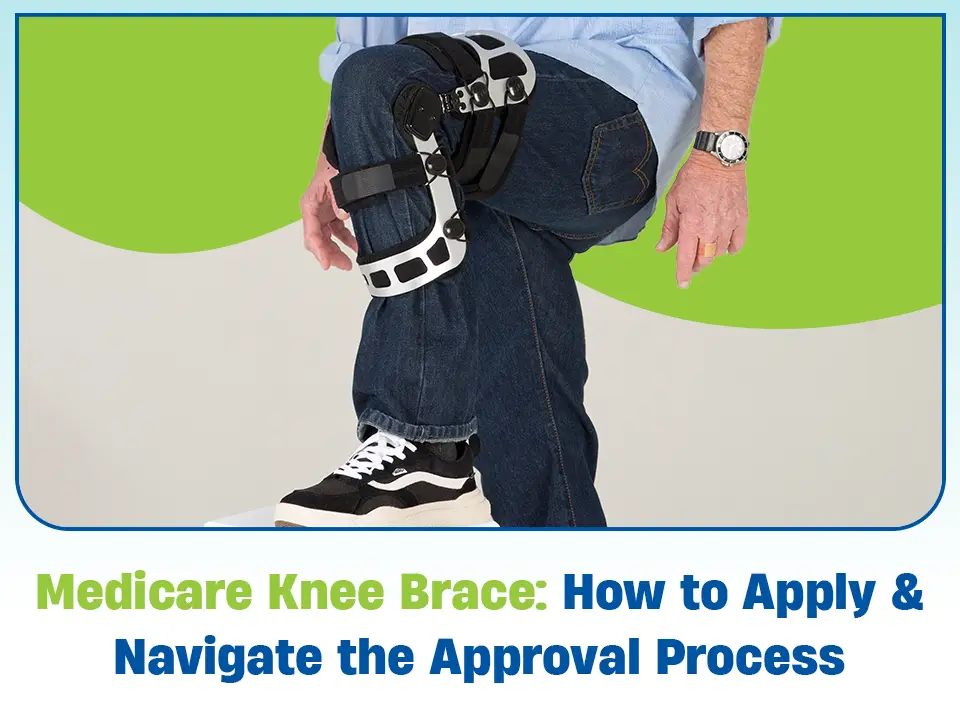Introduction: Understanding Medicare Coverage for Knee Braces
Knee braces play a pivotal role in aiding recovery, enhancing stability, and ensuring day-to-day comfort for individuals grappling with knee issues. For Medicare recipients, the benefits extend further, as this federal health insurance program facilitates access to medically necessary knee braces, reducing both physical and financial burdens. This guide delves deeper into understanding how Medicare can help cover the costs of knee braces, simplifying the application and approval process. By exploring the essentials of Medicare coverage for knee braces, this article aims to equip you with the knowledge to navigate these processes effectively, allowing you to focus more on recovery and less on the logistics.
Eligibility for a Medicare Knee Brace
To successfully navigate Medicare’s provisions for a knee brace, it’s important to thoroughly comprehend the eligibility criteria:
- Medicare Part B Participation: Knee braces are covered under Medicare Part B, which specifically provides for outpatient services, including Durable Medical Equipment (DME) like knee braces. This coverage is contingent upon the brace being deemed medically necessary by a licensed physician.
- Documented Medical Need: The knee brace must be prescribed by your healthcare provider based on a documented medical need. This is typically for conditions that impair mobility or cause significant pain, such as degenerative joint disease, post-operative recovery, or severe physical knee injuries.
- A prescription from a Medicare-Approved Doctor: The prescription for the knee brace must come from a doctor enrolled in Medicare, ensuring that the process aligns with Medicare’s regulations and reimbursement criteria.
- Supplier Requirements: Additionally, the knee brace must be obtained from a supplier that is officially recognized and approved by Medicare to ensure coverage eligibility and avoid out-of-pocket expenses.
- Annual Deductible and Co-Payment: It’s also crucial to be aware that Medicare Part B involves an annual deductible and typically covers 80% of the approved amount after the deductible is met. The remaining 20% is billed to the patient unless covered by secondary insurance.
Understanding these points helps clarify what is needed from both the medical and administrative perspectives to qualify for a knee brace through Medicare, ensuring you meet all necessary guidelines to facilitate a smooth approval process.
How to Apply for a Medicare-Approved Knee Brace
To successfully apply for a Medicare-approved knee brace, follow these detailed steps to navigate the process efficiently and effectively:
- Doctor’s Evaluation and Prescription: The first step is to have a detailed evaluation with a healthcare provider who is enrolled in Medicare. During this appointment, discuss your knee issues thoroughly. If a knee brace is deemed necessary, your doctor will write a prescription specifying the type of knee brace needed and its medical justification.
- Choosing the Right Supplier: After obtaining your prescription, the next step is to find a Medicare-approved supplier that specializes in Durable Medical Equipment (DME). Ensure that the supplier is enrolled in Medicare and meets all Medicare Supplier Standards to avoid issues with coverage.
- Submitting Documentation: Along with your prescription, you will need to provide Medicare with relevant medical documentation. This includes medical records that outline your knee condition, the doctor’s notes from your evaluation, and any other tests or imaging that support the need for a knee brace.
- Filling Out Required Forms: Complete any necessary forms provided by the DME supplier, which might include Medicare forms that verify your eligibility and coverage details. Your supplier can assist you with understanding and completing these forms correctly.
- Follow-Up and Fitting: Once your application is submitted and approved, you will need to schedule a fitting appointment with your supplier. This ensures that the knee brace is properly fitted to your body, maximizing its therapeutic effectiveness and comfort.
- Insurance Verification: It’s important for the supplier to verify your Medicare coverage to determine what portion of the cost will be covered and what, if any, co-payments may be required. This step helps avoid unexpected expenses and ensures that all billing is handled according to Medicare’s policies.
By meticulously following these steps, you can streamline the process of obtaining a Medicare-approved knee brace, ensuring you receive the support needed to manage your knee condition effectively.
Read More: Medicare Knee Braces: Coverage, Eligibility, and How to Get Yours
Navigating the Approval Process
Navigating the Medicare approval process for a knee brace efficiently requires awareness and proactive management of your application. Here’s how to effectively handle the process:
- Submission of Documentation: Ensure that all required documents, such as your prescription, detailed medical records that justify the need for a knee brace, and any prior treatment documentation, are submitted promptly. Use a Medicare-accredited supplier who can handle the submission process and knows the specifics of Medicare’s documentation requirements.
- Follow-Up Communications: Stay in regular contact with your supplier to monitor the progress of your claim. Suppliers are typically experienced in dealing with Medicare and can provide updates and guide you through the process.
- Understanding Processing Times: Be aware of the typical processing times for DME claims under Medicare. This understanding can help set realistic expectations and reduce frustration with waiting periods.
- Handling Denials and Appeals: If your application for a knee brace is denied, request a detailed explanation of the denial from Medicare. Review the feedback carefully with your healthcare provider. There may be additional steps you can take, such as providing further medical evidence or correcting any errors in your initial application. Your supplier and healthcare provider can assist in gathering the necessary documentation and resubmitting your claim.
- Appeal Process: If necessary, engage in the Medicare appeals process. This process involves several stages, starting with a reconsideration by another contractor and possibly escalating to an administrative law judge if further appeals are needed. Each stage has specific deadlines and requirements, which your supplier should help you understand and meet.
- Patient Advocacy: Consider seeking support from patient advocacy groups if you encounter persistent difficulties. These organizations can offer guidance and support in navigating complex insurance processes, including Medicare coverage for DMEs like knee braces.
By understanding and actively participating in each step of the approval process, you can enhance your chances of a favourable outcome, ensuring that you receive the knee brace necessary to improve your mobility and quality of life.
Maintaining Your Medicare Knee Brace
Ensuring the continued functionality and effectiveness of your Medicare knee brace involves several key maintenance practices:
- Regular Cleaning: Adhere to the cleaning guidelines provided by the manufacturer. Most knee braces can be cleaned with mild soap and lukewarm water. Avoid harsh chemicals that could degrade the materials of the brace. Allow the brace to air dry completely before wearing it again to prevent skin irritation and damage to the brace components.
- Routine Inspections: Check the brace periodically for any signs of wear and tear such as stretched straps, loose fittings, or breakdown of the brace material. Early detection of these issues can prevent them from becoming more serious problems that might impact the brace’s functionality.
- Proper Storage: When not in use, store your knee brace in a cool, dry place out of direct sunlight. Proper storage helps preserve the materials of the brace and ensures that it remains in good condition.
- Follow-Up Visits: Regular appointments with your healthcare provider are essential, not only for assessing the condition of your knee brace but also for monitoring your overall progress. During these visits, discuss any discomfort or issues you are experiencing with the brace. Your provider can make recommendations for adjustments or even prescribe a new brace if your condition changes or the current brace is no longer appropriate.
- Adjustments as Needed: Over time, your knee brace may require adjustments to continue providing optimal support and comfort. This might be due to changes in your physical condition, weight fluctuations, or the natural stretching of materials. Consult with your healthcare provider or the brace supplier about making these adjustments.
- Replacement Planning: Be aware of the lifespan of your knee brace. Over time, even the best-maintained braces will degrade and may no longer provide the necessary support. Plan for replacement in accordance with your healthcare provider’s recommendations and Medicare coverage guidelines to ensure you always have a functional brace.
By implementing these maintenance tips, you can significantly extend the life of your Medicare knee brace, ensuring it provides the best possible support for your needs. Regular care and proper adjustment will help you achieve the most benefit from your brace, contributing to improved mobility and a better quality of life.
Conclusion: Empowering Mobility with Medicare
Navigating the Medicare approval process for a knee brace can significantly improve your quality of life by providing the necessary support to maintain mobility and manage pain. By understanding the steps involved in applying for and maintaining a Medicare-approved knee brace, you can take active control of your orthopedic health and ensure that you continue to enjoy an active and fulfilling lifestyle. By following this guide, you’ll be well-prepared to navigate the complexities of Medicare coverage for knee braces and make informed decisions about your healthcare needs.









